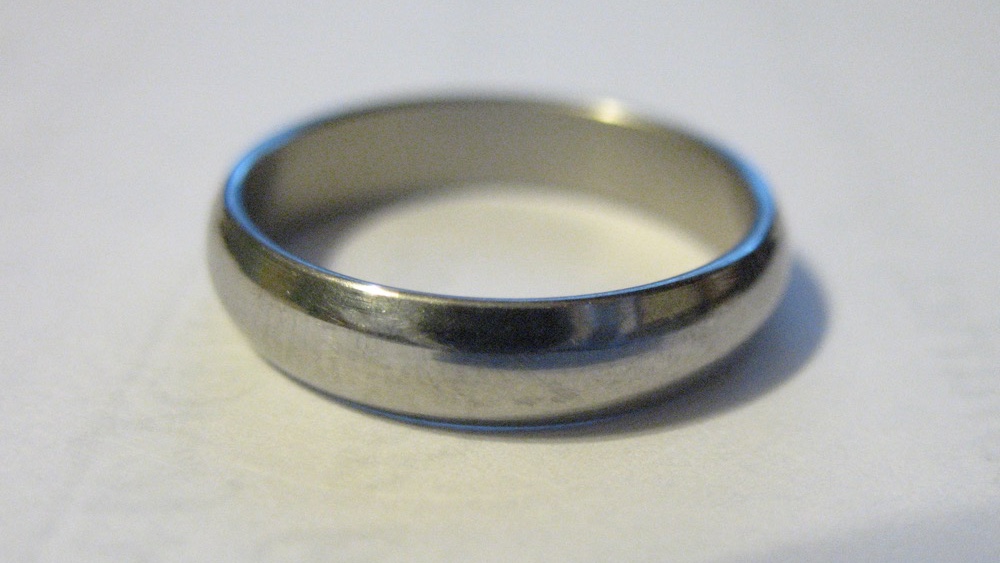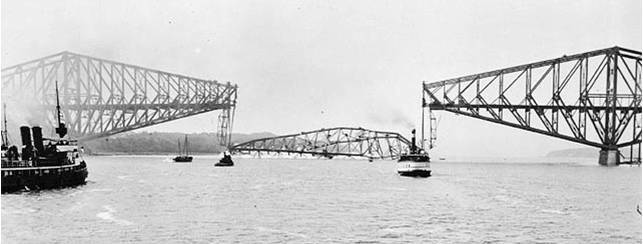When I’m working, I wear a plain silver band on the little finger of my dominant hand. There’s no inscription; it’s completely unadorned save the scratches it’s picked up over the years.
It’s not a fashion statement, but if you think I wear it well, thank you. According to the Art of Manliness, a ring on the little finger symbolizes intellect, a great ability to express yourself, or a strong intuition. I can’t dispute any of that.
It’s an Engineer’s Ring, given to those in the United States who have completed a qualified engineering degree or are a licensed professional engineer.
The story behind the ring, as I remember it:
The Quebec Bridge was to be the first bridge over the St. Lawrence River at Quebec. Construction began around the turn of the 20th century.
The engineer who designed the bridge had never worked on a project of that size before, and it didn’t have the structural strength to support its own weight. Despite early warning signs, a combination of vanity and political pressure pushed the project forward. On August 29, 1907, the bridge collapsed, killing 75 workers.
Understandably, the second attempt at building the bridge was under even more pressure than the first attempt. Corners were cut to get the project back on schedule and under budget. Those decisions caught up with them on September 11, 1916, when the bridge collapsed a second time, killing another 13 workers.
The center span of the Quebec Bridge collapsed as it was being raised into place. September 11, 1916.
After the second collapse, the chief engineer took a length of pipe from the wreckage, had it sliced into rings, and distributed one to each man working on the project. The ring was to be worn on the little finger of their dominant hand. Every time they bumped it while signing off on a design, or turning a tool, it was to remind them that peoples’ lives hung in the balance of their judgement.
No more shortcuts. From then on, every man was to do his best work and nothing less.
(I’ve never been able to corroborate that story of the cut pipe, but that’s how I remember the story being told. Officially, the ring is merely symbolic, with no actual historic connection.)
In 1925, Herbert E. T. Haultain, professor at the University of Toronto, wanted to create a professional oath for Canadian engineers to take, similar to the Hippocratic Oath taken by doctors. He and Rudyard Kipling created “The Ritual of the Calling of an Engineer”, a ceremony which included the bestowal of an iron ring, rough and hammered from cold iron, without beginning or end. The movement came to the United States as the Order of the Engineer in 1970, with a simple, stainless steel band.
If you work in a field where lives are at stake, my hat is off to you. I don’t, but that doesn’t excuse me from bringing my A game. No matter our line of work, we all have the resposibility to deliver the best work we know how.
Sometimes, we have to cut corners. There’s never enough time or budget available to do things perfectly, the way we want to. Part of our judgement then becomes to make the safest trade-offs possible. Cut corners aren’t an expense we save; they’re a debt that will come due someday.
Only a few have ever commented on the ring, or asked its significance. Fewer still have recognized it for what it is.
It’s not the fashion statement most assume. It’s a reminder to always act with integrity, character, and honor, because the choices we make can have a bigger impact than we realize.
Question: Do you have a professional or personal code of conduct? Share your thoughts in the comments, on Twitter, LinkedIn, or Facebook.


